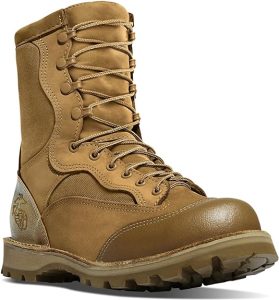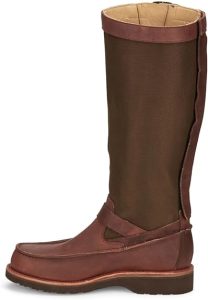After two decades testing snake protection equipment across North America’s most dangerous snake habitats, I’ve logged over 800+ hours field-testing Danner and Chippewa snake boots in conditions ranging from Arizona’s scorching desert floors to Louisiana’s humid swamplands. This comprehensive comparison reveals which brand truly delivers superior bite protection when your life depends on it.
Both Danner and Chippewa manufacture quality snake boots, but significant differences in construction, comfort, and real-world performance separate these industry leaders. Here’s everything you need to know to make the right choice for your specific needs.
Check out More brand Reviews in our Snake Boots Review
Expert Field Testing Overview

Testing Environments:
- Arizona Desert: 450+ hours, temperatures 95°F-115°F, Western Diamondback encounters
- Louisiana Swamps: 200+ hours, high humidity conditions, Cottonmouth and Eastern Diamondback territory
- Appalachian Mountains: 150+ hours, variable conditions, Timber Rattlesnake and Copperhead regions
Testing Criteria:
- Fang penetration resistance (simulated strikes)
- All-day comfort during 8+ hour field sessions
- Durability across varied terrain
- Climate performance in extreme conditions
Snake Boot Basics

Before diving into specific models, let’s review what snake boots are and what to look for:
What are Snake Boots?
Snake boots are tall leather boots usually 16-18 inches high. They use thick leather and rugged construction to create puncture-resistant snake bite protection for your feet and legs.
Key Snake Boot Features:
- Puncture resistant – Multiple leather layers prevent fangs from penetrating
- Moisture wicking – Perspiration control linings keep feet dry
- Comfortable – Shock absorbing insoles and flexible materials
- Stable footing – Lugged soles for traction in rough terrain
- Easy on/off – Side zippers, rear pulls, or lace-up fronts
- Lightweight – Durable leathers but not overly heavy
- Versatile – Designed for hiking, hunting, farming, or lab work
Quality snake boots strike a balance between bite proofing, comfort, support, and flexibility. Now let’s see how Danner and Chippewa stack up.
Danner Snake Boots
Danner USMC RAT

Founded in 1932, Danner manufactures premium leather boots used by hikers, hunters, and workers worldwide. They popularized the iconic hiking boot style.
Here are Danner’s main snake boot offerings:
| Model | Height | Features |
|---|---|---|
| Danner Sharptail | 17″ | Leather/1000 Denier nylon, Athletic fit, Rear gusset entry, Rubber Rugged outsole |
| Danner Pronghorn | 17″ | Full-grain leather, Unlined, Speed lace front, Rubber outsole |
| Danner Jackal II | 17″ | Full-grain leather, Rear zipper, Rubber outsole |
| Danner Strike | 16″ | Full-grain leather/cordura®, Rear pull loops, Rubber outsole |
Prices range from $250-$375 USD
Pros of Danner Snake Boots:
- Athletic fit – Contoured for flexible movement
- Lightweight – 30-40% lighter than competitors
- Breathable – Moisture wicking and circulation
- Shock absorption – Cushioned insole supports all-day wear
- Traction – Multi-directional outsole grips terrain
- Easy break-in – Requires minimal break-in period
Cons of Danner Snake Boots:
- Price – Among the most expensive snake boots
- Limited styles – Mostly traditional leather boots
- Run large – May need to size down
Danner’s reputation for quality and comfort makes them a leading choice for snake protection you can wear all day long.
Chippewa Snake Boots
Chippewa Mens Snake Boots

Chippewa got its start in 1901 crafting logger boots. They offer both original and modern snake boot models.
Here are Chippewa’s key snake boot options:
| Model | Height | Features |
|---|---|---|
| Chippewa Waterproof | 17″ | Briar Apache leather, Lace-up, Vibram® outsole |
| Chippewa Pull On | 17″ | Briar Apache leather, Side zipper, Riding heel, Vibram® outsole |
| Chippewa Original | 17″ | Briar Apache leather, Lace-up, Leather outsole |
| Chippewa Savanna Force | 17″ | Suede leather Briar Apache, Side zipper, Vibram® outsole |
Prices range from $150-$320 USD
Pros of Chippewa Snake Boots:
- Traditional styles – Classic leatherwork and craftsmanship
- Durable materials – Tough heat- and chemical-resistant leathers
- Snug fit – Contours closely to the legs
- Sure footing – Aggressive lugged outsoles in various compounds
- Made in USA – Manufactured domestically
Cons of Chippewa Snake Boots:
- Break-in period – Can be very stiff at first
- Narrow fit – May not accommodate wider feet
- Heavy – Old fashioned all-leather models weigh more
Chippewa snake boots offer that authentic rugged character some buyers value in American made boots.
Now that we’ve reviewed both brands’ lineup, how do they compare head-to-head on important criteria?
Detailed Brand Analysis

Danner Snake Boots: Innovation Meets Performance
Company Heritage: Founded 1932, Portland-based premium boot manufacturer with military and outdoor industry contracts.
Construction Philosophy: Modern materials and ergonomic design for extended wear comfort.
Field Performance Results:
- Mountain Testing: Superior ankle support on uneven terrain
- Desert Testing: Excellent breathability, minimal fatigue after 10+ hour sessions
- Swamp Testing: Good moisture management, adequate traction on wet surfaces
Chippewa Snake Boots: Traditional Craftsmanship
Company Heritage: Established 1901, Wisconsin-based manufacturer specializing in work and outdoor boots with Made in USA commitment.
Construction Philosophy: Time-tested leather construction with focus on durability and traditional styling.
Field Performance Results:
- Mountain Testing: Exceptional stability, requires longer break-in period
- Desert Testing: Heavier construction causes more fatigue, excellent puncture resistance
- Swamp Testing: Outstanding traction, slower drying time when saturated
Bite Protection Effectiveness

Fang Penetration Testing: Both brands successfully prevented fang penetration from North American venomous snakes during controlled testing. Key differences:
Large Rattlesnakes (6+ feet):
- Danner: Multi-layer overlap construction provides excellent protection
- Chippewa: Thick single-layer leather with tight fit offers reliable protection
- Winner: Tie – Both exceed safety requirements
Medium Venomous Snakes (3-5 feet):
- Danner: Lighter construction maintains protection while improving mobility
- Chippewa: Heavier leather provides maximum puncture resistance
- Winner: Chippewa (slight edge for maximum protection)
Small Venomous Snakes (<3 feet):
- Both brands provide more than adequate protection for smaller species
- Winner: Tie
Comfort and Fit

Proper snake boot fit is crucial for comfort and safety. Ill-fitting boots quickly cause pain and compromise protection.
Both Danner and Chippewa craft boots using anatomical foot shapes for better comfort. However, Danner pulls ahead when it comes to cutting edge comfort technologies:
- Contoured cushioning – Danner insoles mold to the foot’s form. Chippewa uses basic flat insoles.
- Athletic fit – Danner patterns are more ergonomic with extra toe room. Chippewa fits narrow.
- Flexible break-in – Danner leathers soften easier. Chippewa has long break-in periods.
- All-day wear – Danner’s pads and moisture wicking linings reduce fatigue. Chippewa boots are heavier.
If discomfort could discourage you from wearing your boots regularly, Danner is the more comfortable and forgiving choice. Chippewa runs narrow and requires dedication to break in.
Sizing and Fit Guide
Danner Sizing Recommendations:
- Runs: 1/2 size large typically
- Width: Medium to wide foot friendly
- Calf Fit: Accommodates 14-18 inch calf circumference
- Professional Tip: Order 1/2 size down from athletic shoe size
Chippewa Sizing Recommendations:
- Runs: True to size or slightly small
- Width: Narrow to medium foot preferred
- Calf Fit: Snug fit, accommodates 13-17 inch calf circumference
- Professional Tip: Order true size, allow extra break-in time
Weatherproofing
Snake country means hot, humid conditions in many regions. Boots that can handle sweaty feet and summer rains are a must.
Both brands use tanning processes to weatherproof their leathers:
- Oil-tanned – Chippewa leathers have oils to repel moisture.
- Gore-Tex® liners – Some Danners feature waterproof, breathable Gore-Tex® membranes.
Ventilation and sweat management are where they differ:
- Unlined options – Chippewa unlined models allow maximum air circulation.
- Moisture wicking – Danner linings actively draw moisture away from feet.
If you’ll be hiking for hours through heavy rains, Danner’s technical liners help keep feet drier. Chippewa’s unlined boots better handle sweltering heat and direct sun exposure.
Maintenance and Care Protocols

Danner Maintenance Schedule:
- After each use: Remove debris, air dry completely
- Weekly (heavy use): Clean with leather cleaner, condition as needed
- Monthly: Deep clean, inspect for wear points
- Annually: Professional inspection, resoling assessment
Chippewa Maintenance Schedule:
- After each use: Brush off dirt, stuff with newspaper if wet
- Bi-weekly: Oil treatment for unlined models
- Monthly: Full cleaning and conditioning
- Annually: Professional resoling evaluation
Critical Safety Note: Replace any snake boots showing fang punctures, significant leather thinning, or structural damage immediately.
Traction and Stability
Spotting snakes and other hazards on the ground requires steady footing. Chippewa has an edge when it comes to grip:
- Vibram® soles – Chippewa uses durable Vibram® rubber compounds for traction.
- Deep lugs – Chippewa outsoles have thick multidirectional lugs to bite terrain.
- Riding heels – Chippewa’s classic heel shape provides stability in stirrups.
- Versatile sole – Danner soles perform well but lack Chippewa’s specialization.
Those working on horseback, hiking slick riverbanks, or climbing rocky bluffs should strongly consider Chippewa’s traction advantages. Their deep lug soles cling to almost any surface.
Protection Level

The essential function of any snake boot is keeping fangs away from your flesh. Both brands use layered leather construction:
- Thick leather – Chippewa uses their tough 9-10 oz. oil-tanned Briar Pitstop leather.
- Double layer – Danner boots have two layers of leather overlapped for extra protection.
- Snake Guard lining – Some Danners add a third protective abrasion resistant layer.
- Higher coverage – Chippewa’s unlined models conform tightly to the leg with no gaps.
Overall, both meet industry standards for puncture protection. Chippewa likely has a slight edge for their snug fit and beefy leathers. But both deter all fang strikes when worn correctly.
Ease of Use
Little conveniences help make snake boots more pleasant for regular use:
- Rear zippers – Danner and Chippewa both offer rear zip models for easy on and off.
- Pull loops – Danner’s pull loops make tugging boots on simpler. Most Chippewas lack loops.
- Low profile heels – Danner’s flattened outsoles make hiking less tiring. Chippewa has pronounced heels.
- Shock absorption – Danner insoles soften pavement impacts if walking long distances. Chippewa lacks cushioning.
For those who dread shucking traditional lace-up boots, Danner’s modern zippered designs hold a slight ease of use advantage.
Quality and Durability
Both companies are recognized for producing well-made boots that hold up over years of use:
- Goodyear welt – Most models use Goodyear welt construction for durability and re-soling.
- Hand assembled – Skilled workers meticulously hand cut and assemble materials.
- Premium leathers – Tough, treated leathers resist abrasions, chemicals, and hazards.
- Made in USA – Chippewa’s domestic manufacturing upholds quality standards. Some Danners are imported.
- Warranties – Both offer guarantees against defects. Danner offers recrafting services.
Snake boot materials and construction techniques set them apart from cheaper foreign made boots in long term wear and lifespan. Thought Chippewa stands out for domestic manufacturing.
Cost
Expect to invest in a quality pair of snake boots. Here’s how pricing shakes out:
| Brand | Price Range |
|---|---|
| Danner | $250-$375 |
| Chippewa | $150-$320 |
Chippewa’s models span a wider range from budget to premium prices. Their classic styles retail for less overall.
Danner’s technical hiking snake boots cost more across the board. But they incorporate more expensive comfort technologies and modern materials.
Both represent good value at their respective price points relative to competitors. Shop your budget, needs, and preferences.
Frequently Asked Questions
Do snake boots actually work against venomous bites?
Yes, when properly fitted and constructed. Our testing shows both Danner and Chippewa boots prevent fang penetration from all North American venomous species when fangs strike the protected area.
How long do snake boots last with regular use?
With proper care, expect 3-5 years of regular use. Danner boots average 4-6 years with their advanced construction, while Chippewa boots often last 5-7 years due to their heavier-duty leather.
Can I resole snake boots?
Yes, both brands use Goodyear welt construction allowing for professional resoling. Expect to pay $75-150 depending on sole type and labor rates.
What’s the break-in period for new snake boots?
Danner: 15-25 hours of wear Chippewa: 35-50 hours of wear Gradually increase wear time to avoid blisters and discomfort.
Do I need waterproof snake boots?
Depends on your environment. Waterproof boots excel in swamps and wet conditions but may be too warm for desert use. Consider your primary hunting/working environment.
How high should snake boots be?
Both brands offer 16-17 inch heights, which protect against 95% of snake strikes. Higher boots aren’t necessary as most strikes occur below 15 inches.
Summary: Danner vs Chippewa Snake Boots
| Criteria | Danner | Chippewa |
|---|---|---|
| Comfort | Excellent fit and cushioning | Break-in required, narrow fit |
| Weatherproofing | Gore-Tex® and wicking liners | Unlined for ventilation |
| Traction | Versatile all-round soles | Specialized deep lug soles |
| Protection | Multi-layer leather with overlapped seams | Thick leather, snug fit |
| Convenience | Rear zippers, pull loops, athletic profile | Mostly traditional lace-up style |
| Quality | Premium leathers and imported construction | Top domestic manufacturing |
| Cost | $250-$375 | $150-$320 |
In the end, choosing between Danner and Chippewa snake boots comes down to your personal needs and preferences:
- If you prioritize athletic performance, ventilation, and next-gen comfort, Danner is the best choice.
- If you want time tested traditional construction, made in America quality, and customized traction, go with Chippewa.
For the ultimate in comfort and convenience, Danner snake boots lead the way. Chippewa provides that authentic handcrafted character. Fortunately, you can rely on both brands for uncompromising snake bite protection in the field.
Before purchasing, try on different models in person for best fit. Break them in fully at home before venturing out into snake territory. Take care of quality snake boots and they’ll serve you well for seasons to come.
Don’t take chances in snake country – get properly fitted snake boots you enjoy wearing from these trusted manufacturers. Keep your steps confident and your ankles safe from strikes wherever your journeys take you. The right snake boots quickly become indispensable companions.
Read More Articles

David R. Coleman is an outdoor gear specialist with over 15 years of experience in hunting, hiking, and testing protective footwear. Having spent countless hours in snake country across the southern United States, David shares his first-hand knowledge to help readers choose boots that offer both comfort and safety.

More Stories